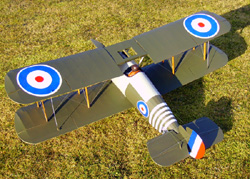Sopwith Snipe 41.44" N159
Skill Level: Advanced
More
than 550 parts
SPECIFICATIONS
Scale:
1/9
Prop:
12x6
Channels:
R/E/A/T
Wheels: Balsa Ply w Neo Tires
Airfoil Type: flat bottomed
Wing Area: 479 sq in, Early Variant or 495 sq in, Late Variant
Cowl:
built up balsa and plywood with interlocking
bayonet ring mount
Designer:
M.K.
Bengtson
Weight:
~28 oz
Spinner:
N/A
Prototype
By: Frank Jaerschky
Power
System: AXI 2217/20
FEATURES
Designed
for the AXI 2217/20 Direct Drive brushless motor but any planetary drive power
system with a maximum diameter of ~1 1/8" with equivalent power should work
as well.
- One Piece Design
- Flat bottomed airfoils
- Optional layout for ailerons and tail for Early or Late variants
- Pull-Pull rudder and ailerons
- Dummy engine that doubles as a motor mount
- Sub ribs
- Cowl design has a camera bayonet mount style attachment mechanism for fast and seamless mounting and removal
HISTORICAL SIGNIFICANCE
In service, the Snipe performance was exemplary. One of the most amazing dogfights of the war occurred in a Snipe on 27 October 1918. Major W.G. Barker, a Canadian, was on patrol in a Snipe numbered E8102 with a group of Camels of 201 Sqdn. Flying over the Foret de Mormal, Barker shot down an enemy two seater. Barker was then wounded in the leg by ground fire. As he spun down trying to regain control of the aircraft, he found himself in the middle of a formation of fifteen Fokkers (presumably DVII's). He attacked them and getting to with in thirty feet of one, shot it down. However, he was wounded again and fainted. Regaining consciousness, he was attacked by the rest of the formation. He then shot another Fokker down only to be wounded again, shattering his elbow. Fainting again and once more regaining control of his spinning aircraft, he noticed smoke coming from his aircraft. Believing that a fire had started, he tried to ram a Fokker but instead shot it down at close range. As he tried to escape, eight Fokkers blocked his dive. In spite of not having the use of his legs and one arm, he evaded the fighters and brought his aircraft down to ground level and then flew it until he crashed near a balloon winch. He was rescued and was given the last Victoria Cross of the war for a gallant deed in the air.




